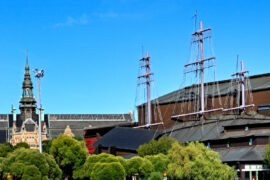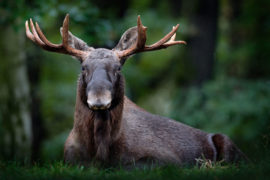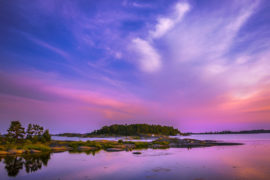With its thousands of lakes, pristine scenery and Arctic climate, Sweden is a brilliant (and beautiful) destination for ice fishing.
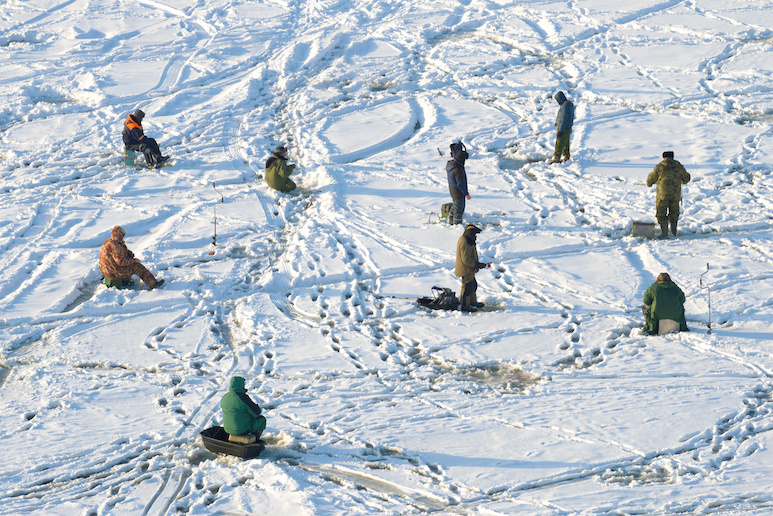
Swedes have long enjoyed this traditional winter activity, and now visitors are waking up to the fun of the sport.
If you’ve never tried it before, ice fishing an atmospheric activity that you can try on your own (if you’ve got the right gear!) or you can do as part of a group on an entertaining guided ice fishing tour.
But what sort of things can you catch? And when is the best time to go? Read on to find out all you need to know about ice fishing in Sweden.
Ice fishing, you say?
So, what is ice fishing? And where can you do it? Well, at its most basic, ice fishing involves drilling a hole in frozen water and fishing through the hole with a rod.

A traditional activity of the native Sami people, who have been ice fishing in Lapland for hundreds (and perhaps thousands) of years, it’s now become a popular activity for Swedes around the country.
Since Sweden has plenty of rivers and thousands of lakes – more, in fact, than any other country in Europe – most Swedes live close to a body of water where they can fish.
And, as the northern reaches of the country lie above the Arctic Circle, enough of these lakes freeze over in winter that you can fish though the ice.
How ice fishing works
So, what can you expect when you go ice fishing and what is the appeal? We think those who like fishing anyway will love the idea of drilling a hole in the ice, setting up the rods and waiting for the fish to bite.
Add to this the fun of lighting a brazier on the frozen lake, making coffee and warming up round the fire, to a backdrop of snowy landscapes.
There are certain techniques that are unique to ice fishing, such as drilling a hole in the ice first with an ice auger.
Jigging is also an effective technique that involves using a special jigging rod and lures to attract the fish. The lure is dropped into the ice hole and then quickly raised again to initiate the movement of a small baitfish.
Tip-ups are often used too to alert the angler to any action beneath the ice. They are attached to the rod and set off a flag when the tension increases on the line due to a biting fish.
Where can you go ice fishing in Sweden?
Since Sweden has so many lakes and rivers, you can go ice fishing pretty much anywhere – provided the water’s frozen, of course.
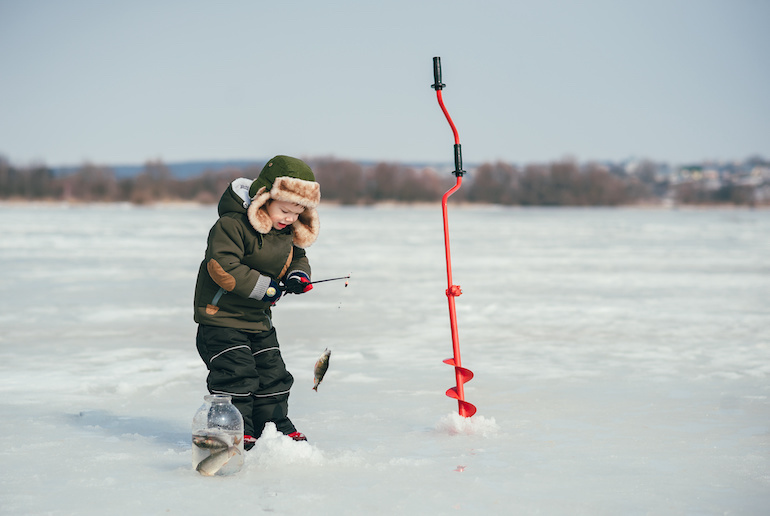
Many Swedish anglers have their favourite spots that are close to home, and you don’t have to even leave the city to get out on the ice.
At the top of the Gulf of Bothnia, Luleå, for example, has ice fishing on the frozen sea, close to the city centre. It can be a surreal experience fishing on the frozen sea, with the lights and buildings of a city as a backdrop!
And we also like Lake Locknesjön, just outside Östersund in the centre of Sweden, which is one of Sweden’s cleanest lakes and known for its high concentration of Arctic char.
However, our top spots are Abisko and Kiruna, high up in the Arctic Circle in the north of Sweden by the Norwegian border.
We think they are good options, in particular because of the stunning scenery, but also because their location means that there is ice on Lake Torneträsk for around six months of the year.
Both towns run guided ice fishing tours, so that beginners can learn the techniques of ice fishing safely, without having to splash out on all the equipment.
And there are plenty of other activities nearby too, such as visiting the ice hotel, northern lights tours, dog sledding and snowmobile trips.
3 fun ice fishing tours in Sweden
If you’ve never been ice fishing before, we strongly recommend taking a guided tour for a whole host of reasons. First of all is safety – an experienced guide will know when and where the ice is thick enough to go out on.
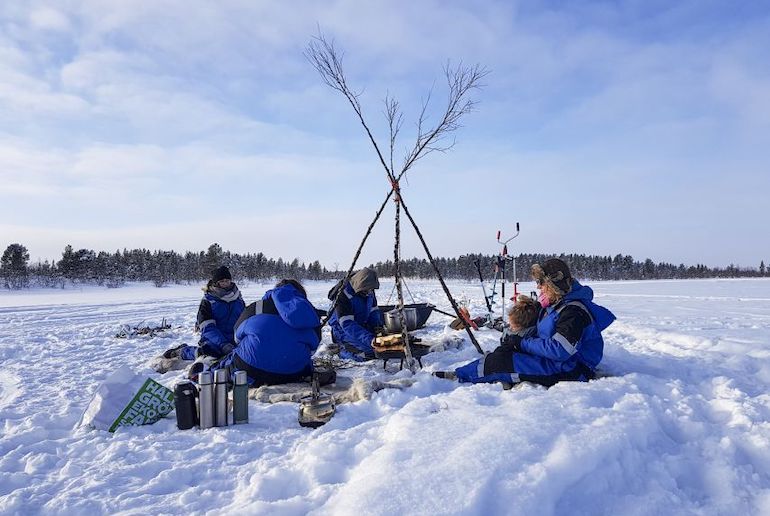
Secondly, a guide will give you tips and advice on techniques specific to ice fishing, such as jigging and using tip-ups.
A guided tour will also include all the gear and any licenses you may need. And finally – and this is a pretty obvious one – it’s actually more fun going with a group of people! Here are our favourite fun ice fishing tours in Sweden.
Arctic ice fishing adventure in Abisko
We love this trip, where a small group fish for Arctic char on the frozen Lake Torneträsk with a beautiful background of snowy mountains. If you’re lucky, you can cook your catch and eat it round a campfire.
Snowshoe and ice fishing from Kiruna
This fun trip involves involves exploring the snowy forests by snowshoe, then fishing on a frozen lake. You’ll warm up afterwards round an open fire by a Nordic tipi.
Snowmobile and ice fishing in Sollefteå
And for the ultimate adventure, we recommend this snowmobile trip out to a frozen lake where you can learn how to ice fish. Lunch and dinner are included, plus you get to warm up afterwards in an outdoor hot tub beneath the stars.
What can you catch?
The most common fish that you’re likely to catch when ice fishing in Swedish winter are perch, trout, brown trout, grayling, whitefish, pike, zander and Arctic char.
Of course, what you can catch depends on where and when you are fishing. Around Luleå, for example, you’re most likely to catch Arctic char, zander, pike, perch and trout in winter.
Lake Torneträsk near Abisko is known for its Arctic char in winter, which is probably the most prized fish among ice fisherfolk, along with trout.
Of course, not all the fish is caught to eat. There are strict regulations as to how many fish you can take out of the water (see below). Ice fishing is a sport, after all, and most fish are returned to the water.
Pike is generally returned to the water as it can’t just be cooked and eaten straight away, and needs a lot of preparation before cooking.
When to go
Clearly you need ice that’s thick (and safe) enough to walk on, so winter is the best time to go. However, the ice fishing season varies considerably depending on how far north you are.
In the central district, around Åre and Östersund, for example, the ice is usually thick enough from December to April.
Further north, however, the season is longer and Lake Torneträsk is usually frozen from December to May.
If you have the option, we recommend early spring, as the lakes are still frozen, but the daylight hours are getting longer and there’s a chance of some sun to warm you up while you’re on the ice.
What gear do you need?
One of the main reasons why we recommend taking a tour is that all the gear is provided, including warm, waterproof overalls. If you plan to go out independently, you’ll need:
- An ice auger or drill
- Fishing rods or a jigging rod
- Fishing lines
- A tip-off
- Bait
- Thermal layers
- Warm, waterproof overalls
- Thermal gloves and hat
- A portable chair – you don’t want to be sitting on the ice!
- A shelter
If you do want to have a go yourself, stores such as Iksu in Sarek rent out ice drills and rods.
Licenses and regulations
You’ll need a fishing permit to go ice fishing in Sweden in all but the country’s five largest lakes, Vänern, Vättern, Hjälmaren, Mälaren and Storsjön. You don’t need a licence to go ice fishing in the sea.
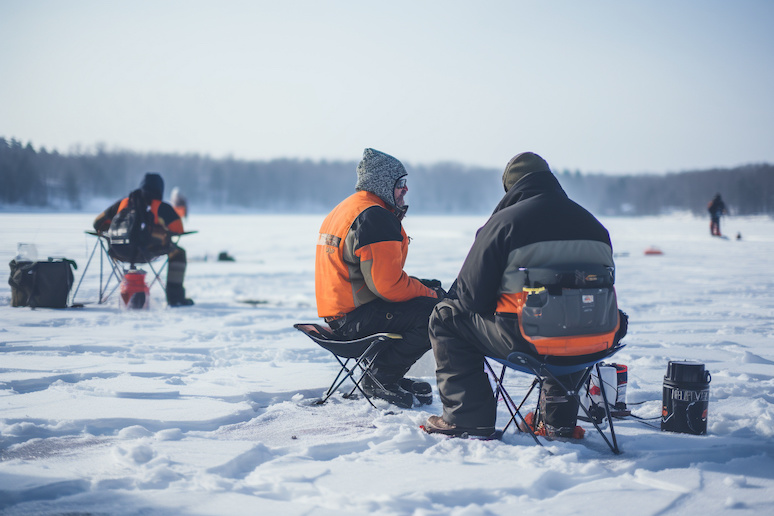
Some lakes are private and have their own licences and permits. Fiskekarten is a useful website, which gives full details on where you are permitted to fish in each lake, where to get licences and which fish you can catch.
Licences can often be bought at local outdoor sports stores or online. You can expect to pay around SEK 100–500 a day for a licence.
There are also regulations as to which fish you can catch and eat. The golden rule is that you should only take what you need for one day’s lunch and dinner. The rest should be released.
There are also limits as to which species can be caught at certain times of the year and strict rules about the size that can be caught.
When you buy your permit, you will be told which fish you are allowed to catch.
Staying safe
Obviously you shouldn’t just head out onto the ice without knowing how thick it is or checking the weather conditions. Again, we recommend taking a tour since your guide will know the safe places to go.
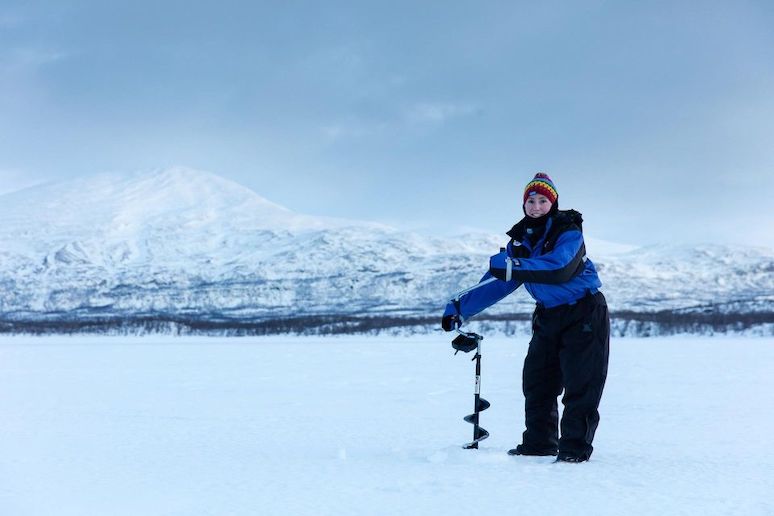
If you do head out on your own, take local advice about where is safe to fish and check the weather conditions first. Never walk on ice that is thinner than 10cm.
Always test the thickness of the ice before stepping on it by drilling a few holes. And keep checking through the day, as the ice can melt quickly on a sunny day.
Avoid river or stream inlets, as the ice is always thinner where there is running water.
If you’re going out somewhere remote, always tell someone where you are going. And ideally, don’t go alone – bring a friend who can raise the alarm if there’s an accident.
Come properly prepared. Spending several hours on a frozen lake is cold work, so make sure you wear thermal layers, a warm jumper and jacket, plus waterproof overalls.
Also, the wind-chill out on a frozen lake can be numbingly-cold so we recommend taking a portable shelter too.
Is it really okay to go ice fishing?
Conservation of fish stocks is of vital importance, and some lakes will close down their fishing entirely, or ban fishing of a certain species if stocks get low.
Because most of Sweden’s lakes need licences, the conservation of local fish populations is generally well regulated.
But, the best way to ensure your ice fishing is sustainable is to stick to the rule of only taking what you can eat in one meal and returning the rest, and only taking fish of the regulated size.
So, these are our top tips for ice fishing in Sweden – and our favourite places. What are yours? Share your favourite ice fishing spots in the comments below.
See also:
The 11 best ski areas in Sweden
Skiing in Sweden
Seeing the Icehotel on a budget



